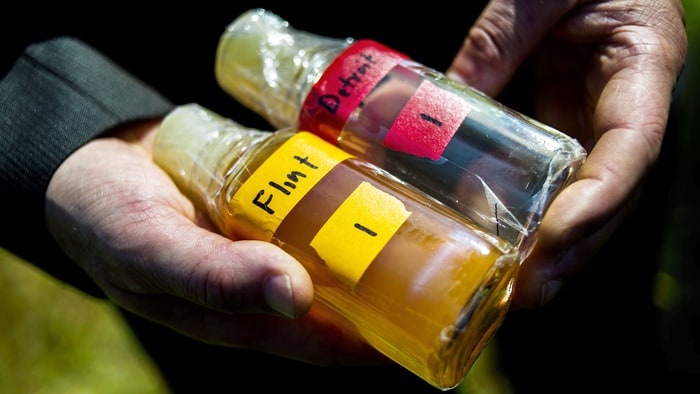This post was adapted from an assignment UEP student Elijah Romulus wrote for the Cities in Space, Place, and Time class. The assignment was an analysis of a policy created after 1950.
Flint Water Advisory Task Force Final Report

Credit: Jake May/AP
Virginia Tech professor Marc Edwards shows the difference in quality between Detroit and Flint water after testing.
Introduction
Close to a century after the first city plan of Flint, Michigan was released, the city went from a growing metropolis to a declining city facing disaster. On December 14, 2015, Mayor Karen Weaver declared the city of Flint in a State of Emergency. An environmental and public health disaster that was traced to the city switching its water source to the Flint River in 2014, a manmade disaster. Flint, once a bustling satellite of the Motor City, Detroit, was now in the headlines for municipal water contamination and lead poisoning in its community. To this date there is still lead in the Flint water despite efforts to fix the problem. The governor of Michigan, Rick Snyder appointed a Flint Water Advisory Task Force to report on the situation. This paper will analyze the Task Force’s 116-page report, which proposed reforms and policies through 44 recommendations that stretch across 10 different local, state, and federal institutions and agencies. The paper focuses on five recommendations in particular.
Recommendations
1) Michigan Department of Health and Human Services (MDHHS): Ensure that MDHHS is transparent and timely in reporting and analysis of aggregate data regarding children’s blood lead levels. MDHHS data regarding lead levels shall be provided to individuals and organizations, based on their expertise, upon request and in cases when the interpretation of data by MDHHS is questioned.
The MDHHS recommendation stated above follows one finding by the taskforce that the department was slow to analyze the data it had on children’s blood lead levels. Furthermore, there was reluctance to share the data it had with Dr. Mona Hanna-Attisha, a pediatrician who was investigating lead poisoning among her patients. Likewise, MDHHS did not cooperate with Professor Marc Edwards, who was helping residents test the city’s water. Based on the Task Force’s introduction as well as the remainder of the executive summary, they found failure of state government at all departments and this recommendation reflects that. The MDHHS was found to be non-transparent and even defensive in its handling of the water crisis.
2) State-Appointed Emergency Managers: Review Michigan’s Emergency Manager Law (PA 436) and its implementation, and identify measures to compensate for the loss of the checks and balances that are provided by representative government.
On December 26th 2012 Michigan Governor Rick Snyder approved senate Bill No. 865, introduced by state senator Phil Pavlov. This bill was later named the Local Financial Stability and Choice Act, Act 436 of 2012. This bill in essence installs emergency managers, EMs, in cities, municipalities, and school districts deemed in a financial crises by the state, in lieu of the elected governance, granting the EM full executive power. The topic of emergency management was one of great tension before and after the Flint Water Crisis. Act 436, though passed in 2012, comes from a long line of similar acts dating back to 1990. The Task Force found in that the state’s EM law could improve to ensure protection of public health and safety not be lost in the name of financial urgency.
3) United States Environmental Protection Agency: Exercise more vigor, and act more promptly, in addressing compliance violations that endanger public health.
In another case of an agency waiting too long to take action, the US Environmental Protection Agency (EPA) was also responsible in the Flint Water Crisis. As early as June 2015, EPA officials were relaying concerns for the drinking water in Flint but upper management was hesitant to take action.
4) Environmental Injustice: Issue an Executive Order mandating guidance and training on Environmental Justice across all state agencies in Michigan, highlighting the Flint water crisis as an example of environmental injustice. The state should reinvigorate and update implementation of an Environmental Justice Plan for the State of Michigan.
Since the environmental disaster occurred, many journalists, academics, and citizens alike have equated this to an issue of environmental racism. The city of Flint is a majority-minority city with 57% of the population reported to be African American according to the 2010 census. While there is nothing that points directly to environmental racism, there is a lack of environmental justice laws to protect citizens as noted by the Task Force. It urged the governor to pass an executive order to be proactive in the face of environmental injustices and not be reactive in the event of another crisis.

Credit: Jake May/AP
Gov. Snyder apologized, promising to fix the problem, but critics call the effort “too little, too late.”
5) State-wide: Use the occasion of the Flint water crisis to prompt local and state re-investment in critical water infrastructure, while providing mechanisms to advance affordability and universal access to water services.
According to the Detroit news: Elevated blood-lead levels are seen in a higher percentage of children in parts of Grand Rapids, Jackson, Detroit, Saginaw, Muskegon, Holland and several other cities, this plays right into the Task Force’s recommendation to update all of Michigan’s water infrastructure. It was not only that the city of Flint switched to a corrosive water source, but the pipes were filled with lead and city employees were not properly equipped or trained to deal with the conversion of water sources. All these factor into the inadequate water infrastructure that the Task Force described in its report.
The five recommendations above best speak to how the state and federal governments failed the city of Flint according the Task Force’s report. The Task Force did a good job of putting the state and federal governments’ front and center of who is to blame for this environmental disaster. The authors interviewed 63 people from the governor, to doctors, to the ACLU, to citizens of Flint. Notably, they concluded in one finding that ultimate accountability for Michigan executive branch decisions rests with the Governor.
In context
The events that followed the report’s early-2016 release suggest it was indeed influential. In the months following the release of the report, six state employees were charged with criminal offenses from the Michigan Department of Health and Human Services and Michigan Department of Environmental Quality. The employees were originally suspended without pay during the process but a few months later the state reversed its decision and resumed their pay, costing taxpayers up to $500,000 in addition to granting them legal defense by the state’s attorney general. While the report holds the state responsible for the crisis, and likely catalyzed legal action against the state employees, it appears to the writer that government officials and state employees are above the law and rarely if ever face prison sentences.
One issue that seems to be lacking in the conversation of the Flint Water Crisis, however, is the Flint river itself. While there are many calls for environmental justice, it is the writer’s opinion that there should be space for environmentalism as well. The Flint River became so corrosive that it was able to eat through pipes. But without the Flint River, the city would not have experienced its boom in the early 20th century, much like Los Angeles’ dependence on the LA River for its success that Jenny Price described in her essay. Currently, the Flint River is in bad shape and needs attention. Some argue environmentalism is a “white cause” while environmental justice is a so-called “minority cause.” This may factor into the lack of environmentalism work in the majority-minority city of Flint.
While the story of Flint is one of tragedy, there is a positive aspect and it is the citizens of Flint. The citizens took matters into their own hands when the government failed them. While children and adults alike were falling victim to lead poisoning at the hands of state sponsored austerity measures, citizens fought for justice. This was with the help of organizations like the ACLU, doctors and professors, and select state and federal employees with righteous indignation to speak up against injustice. Most recently the fight for justice continued as the groups such as Concerned Pastors for Social Change, Flint Activist Melissa Mays, the ACLU, and the Natural Resources Defense Council (NRDC) filed a lawsuit against the state of Michigan to deliver clean water to households in the city of Flint that don’t have access. Even after the state was found responsible for the crisis, it is still fighting against the suit.
Lessons Learned
Flint, Michigan is a wakeup call for various reasons whether it be environmental justice issues, environmentalism, human rights issues, the harmful effects of austerity, and more. There are citizens in the city of Flint still without reliable drinking water. People will be dealing with the lead poisoning for the rest of their lives and there are more public health issues that have arisen in the midst of the crisis. Flint is an example of what happens when democracy is snatched and technocrats and bureaucrats take control. Flint is an example of big business and profits over people. Flint is an example of what happens to cities that are either poor or poor and majority-minority. As planners, policy makers, and change agents it is important to see what went wrong and what went right with Flint. The question that must be asked is: How can one use his or her position to make positive change even if a particular department or agency moves in a negative direction? Flint cannot be forgotten and the citizens of Flint deserve justice because water is life.
Read the full paper here: Elijah Romulus – Analysis of Flint Water Advisory Task Force Final Report
Works Cited
“Flint Doctor Mona Hanna-Attisha on How She Fought Gov’t Denials to Expose Poisoning of City’s Kids.” Democracy Now! January 15, 2016. Accessed November 27, 2016. https://www.democracynow.org/2016/1/15/flint_doctor_mona_hanna_attisha_on.
“What Did GM & the Governor Know? GM Stopped Using Flint Water Over a Year Before Emergency Declared.” Democracy Now! February 17, 2016. Accessed November 27, 2016. https://www.democracynow.org/2016/2/17/what_did_gm_the_governor_know
Aldridge, Chris. “Pavlov Named Most Conservative, Nominated Michigan Senator of the Year.” Huron Daily Tribune. April 20, 2016. Accessed November 19, 2016. http://www.michigansthumb.com/news/article/Pavlov-named-most-conservative-nominated-7260110.php.
Allen, Robert. “6 state employees criminally charged in Flint water crisis” Detroit Free Press. July 30, 2016. Accessed November 28, 2016. http://www.freep.com/story/news/local/michigan/flint-water-crisis/2016/07/29/6-state-employees-criminally-charged-flint-water-crisis/87697834/
Bosman, Julie. “E.P.A. Waited Too Long to Warn of Flint Water Danger, Report Says.” The New York Times. October 20, 2016. Accessed November 28, 2016. http://www.nytimes.com/2016/10/21/us/epa-waited-too-long-to-warn-of-flint-water-danger-report-says.html?_r=1
Carmody, Steve. “State of Michigan Fighting Federal Court Order to Deliver Water to Flint Homes.” Michigan Radio. November 17, 2016. Accessed November 28, 2016. http://michiganradio.org/post/state-michigan-fighting-federal-court-order-deliver-water-flint-homes.
Davis, Matthew, Chris Kolb, Lawrence Reynolds, Eric Rothstein, and Ken Sikkema. Flint Water Advisory Task Force – Final Report. Report. Office of Governor Rick Snyder, State of Michigan. 2016. http://mediad.publicbroadcasting.net/p/michigan/files/201603/taskforce_report.pdf?_ga=1.147700144.609033213.1458749402
Egan, Paul. “Federal Judge Orders Delivery of Bottled Water in Flint.” Detroit Free Press. November 10, 2016. Accessed November 28, 2016. http://www.freep.com/story/news/local/michigan/flint-water-crisis/2016/11/10/delivery-bottled-water-flint/93613760/.
Eligon, John. “A Question of Environmental Racism in Flint.” The New York Times. January 21, 2016. Accessed November 28, 2016. http://www.nytimes.com/2016/01/22/us/a-question-of-environmental-racism-in-flint.html.
Emery, Amanda. “Police confirm body inside vehicle submerged in Flint River.” MLive.com. April 1, 2016. Accessed November 28, 2016. http://www.mlive.com/news/flint/index.ssf/2016/04/police_confirm_body_inside_veh.html
Fonger, Ron. “Flint water crisis prosecutors tell Appeals Court more criminal charges expected.” MLive.com. September 6, 2016. Accessed November 28, 2016. http://www.mlive.com/news/index.ssf/2016/09/flint_water_crisis_prosecutors_1.html
Fonger, Ron. “State reinstates pay for employees charged with crimes in Flint water crisis.” MLive.com. August 18, 2016. Accessed November 28, 2016. http://www.mlive.com/news/index.ssf/2016/08/state_reinstates_pay_for_emplo.html
Graham, David. “Who is to Blame for Flint’s Lead Crisis?” The Atlantic. March 24, 2016. Accessed November 27, 2016. http://www.theatlantic.com/politics/archive/2016/03/flint-task-force-rick-snyder-blame/475182/
Helms, Matt. “Canadians Deliver Water to Protest Detroit Shutoffs.” USA Today. July 24, 2014. Accessed November 28, 2016. http://www.usatoday.com/story/news/nation/2014/07/24/canadians-deliver-water-to-protest-detroit-shutoffs/13130625/
Hohn, Donovan. “Flint’s Water Crisis and the ‘Troublemaker’ Scientist.” The New York Times. August 21, 2016. Accessed November 27, 2016. http://www.nytimes.com/2016/08/21/magazine/flints-water-crisis-and-the-troublemaker-scientist.html.
Johnson, Jiquanda. “State Oversight Board Restores Power to Flint City Council despite Concerns.” MLive.com. May 26, 2016. Accessed November 28, 2016. http://www.mlive.com/news/flint/index.ssf/2016/05/flint_city_council_powers_rest.html.
Lewis, Chris. “Does Michigan’s Emergency-Manager Law Disenfranchise Black Citizens?” The Atlantic. May 09, 2013. Accessed November 19, 2016. http://www.theatlantic.com/politics/archive/2013/05/does-michigans-emergency-manager-law-disenfranchise-black-citizens/275639/.
Mock, Brentin. “Are There Two Different Versions of Environmentalism, One ‘white,’ One ‘black’?” Mother Jones. July 31, 2014. Accessed November 28, 2016. http://www.motherjones.com/environment/2014/07/white-black-environmentalism-racism.
Mostafavi, Beata. “What Happened Last Time? A Look Back at Flint’s 2002 State Takeover.” MLive.com. November 10, 2011. Accessed November 19, 2016. http://www.mlive.com/news/flint/index.ssf/2011/11/what_happened_last_time_a_look.html.
Oosting, Jonathan. “Michigan Proposal 1: Voters Reject Measure, Repeal Controversial Emergency Manager Law.” MLive.com. November 07, 2012. Accessed November 19, 2016. http://www.mlive.com/politics/index.ssf/2012/11/election_results_michigan_vote.html.
Oosting, Jonathan. “Snyder Signs Replacement Emergency Manager Law: We ‘heard, Recognized and Respected’ Will of Voters.” MLive.com. December 27, 2012. Accessed November 19, 2016. http://www.mlive.com/politics/index.ssf/2012/12/snyder_signs_replacement_emerg.html.
Patrick, Deval. 2014. Executive Order 552. Massachusetts: Office of the Governor.
Price, Jenny. “Remaking American Environmentalism: On the Banks of the L.A. River.” Environmental History, November 12, 2007, 536-55.
Savage, Chris. “The Scandal of Michigan’s Emergency Managers.” The Nation. February 15, 2012. Accessed November 19, 2016. https://www.thenation.com/article/scandal-michigans-emergency-managers/.
Senate Bill No. 865, Sess. of 2012 (Mic. 2012), https://www.legislature.mi.gov/documents/2011-2012/publicact/pdf/2012-PA-0436.pdf
U.S. Census Bureau, “Quick Facts. Flint city, Michigan” People. Accessed November 28, 2016. http://www.census.gov/quickfacts/table/PST045215/2629000
Vasilogambros, Matt. “Upholding Michigan’s Emergency Manager Law.” The Atlantic. September 12, 2016. Accessed November 27, 2016. http://www.theatlantic.com/news/archive/2016/09/michigan-emergency-manager-law/499658/
Woods, Ashley. “Michigan Proposal 1 Results: State Emergency Manager Law Fails.” The Huffington Post. November 07, 2012. Accessed November 28, 2016. http://www.huffingtonpost.com/2012/11/07/michigan-proposal-1-results-emergency-manager_n_2070169.html.
Wilkinson, Mike, Bridge Magazine. “Kids’ lead levels high in many Michigan cities.” The Detroit News. January 28, 2016. Accessed November 28, 2016. http://www.detroitnews.com/story/news/michigan/flint-water-crisis/2016/01/27/many-michigan-cities-higher-lead-levels-flint/79438144/
